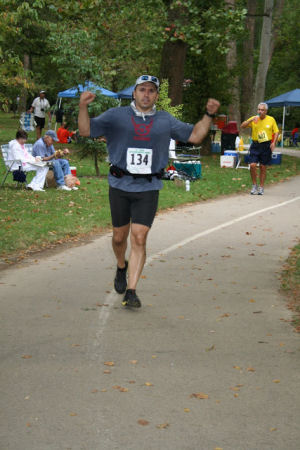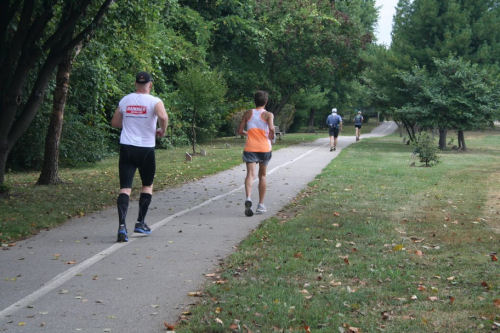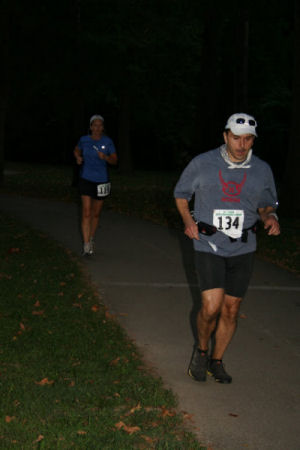I would like to document my training plan for my next major race The Across the Years 24 Hour Ultramarathon on December 31st. This plan will most likely be adjusted slightly as the months go on based on my body’s feedback and my progress… but I do believe it is the high level outline of how I plan to train for this race.
This training outline is defined by some high level goals:
1) I don’t want to stop going to the gym and weight training. In fact I want to get stronger and maybe add a bit more muscle. I simply like the training and what it does for me too much to be willing to stop it for this race. Will continuing serious gym work help me during the race? Possibly in some ways, but it could also have a small negative impact as I will be carrying more muscle than if I didn’t train. Would I be faster and able to go farther more easily if I didn’t weight train… that is most definitely a possibility… but I simply don’t care.
2) I don’t like running enough to do it 5 – 6 days a week. I used to train 5 days a week and have done 6 day a week schedules (even with some two a days through in as well during those weeks) but I usually got hurt at some point and wasn’t able to do much of any other type of training. So I will run 3 days a week (4 times in 8 days) but I am going to be getting other work for my legs in during the week…
3) I believe in the idea of “running on tired legs” being a generally sound training practice. I agree with the notion that if you work your legs hard and often enough that you will have days where you will be running with significantly pre-exhausted legs and by doing so (and attempting to still run well), you will eventually train your legs to run strong when they are tired. This should benefit you late in a race when your legs are going to be tired. I do generally see the validity in this approach but I am going to try to run on tired legs not by running 6 days a week, but by exhausting my legs in other ways when I am not running…
4) So I will performing 2 – 3 hard and fast walks during the week (2 at the beginning of the training cycle and 3 or possibly more as I get deeper into it). There are a couple of reasons why I want to have walking as part of my training and I will discuss those below. While walking doesn’t use your leg muscles in exactly the same way as running (running is basically pushing, while walking is pulling) when performed at a serious pace and with hills walking definitely uses your leg muscles and will add to the cumulative fatigue within them. And I will also be…
5) Adding in leg work at the gym. It has been a few years since I have done any direct leg work (upper legs or calves) using weights (I have been doing drills for some time) and it is going to be tough at first but it will without question add to my legs cumulative fatigue. It will also significantly add to my legs overall strength and endurance and that is going to be key in a race as long as I am planning. I will detail more on my leg work below.
6) Doing one hard stair climbing session a week I will also work my legs in a different way and add to their work and fatigue. I plan on doing Monday stair climbing sessions and will attempt to in the beginning of the plan but to be honest I don’t know if I will be able to tolerate it as the weeks go on and my other training (running, walking and gym leg work) increases in volume. I think when I do climb it will be a bit less intense (slower) than in the past and potentially longer in duration (more floors overall).
So now that you have seen my high level weekly outline, I will go into a bit more detail as to why I incorporated some of the items that I did and more details as to what they will be.
My main enemy I believe I will need to combat physiologically (certainly not my only enemy… there will be many) at this race will be destroyed legs that refuse to move further. I don’t believe cardiovascular fitness will be as big of an issue (it will definitely be an issue and I need to get more cardiovascularly fit but I don’t believe the biggest issue) because I won’t be running at any type of a threshold (aerobic, anaerobic, lactic etc.) for the race. I won’t be going out at 7:00 minute pace! 🙂
So my approach to train my legs to get stronger and move relentlessly forward when they feel like lead is to strengthen then in the gym 3 days a week and to become a strong and fast walker again.
I will be doing 3 – 8 sets (possibly more as the months go on) of different leg and lower back work on Tuesdays, Thursdays and Saturdays. On Tuesdays, I will do leg presses or different forms of squats (some you may have never seen before and I will write about them in future posts). On Thursdays, I will do different exercises for my glutes and various forms of lunges . On Saturdays, I will do romanian, conventional, sumo or trap bar deadlifts. I will also be doing one legged Calf Raise Negatives on Thursdays. These negatives will be a light weight (both standing and seated) that I can push easily with both legs up and then a slower release down on only one leg. I won’t be doing much one legged work (as many running articles prescribe) but will incorporate some for variety and the possible stability benefit, but mostly I want to get stronger and fatigued on two legs at once.
I like the fact that I should balance out my physique a bit better training my legs and the strength gained will provide extra stability. It will also without question tire out my legs and make them sore for when I run the next day (or walk) and this is as important of a benefit as the strength gained. Teaching my legs to run when they really don’t want to and are very much not fresh is the idea. There may be a few weeks (down the road when I am stronger) where I may hit my legs hard in the gym and then immediately jump on the treadmill or go for a 5 – 6 mile run! Sounds almost impossible and will be very hard I am sure, but would also be a crazy level of training intensity that could reap benefits when it is 2am and I have been out on the course for 17 hours. Is this approach the same as running 6 days a week? It isn’t. Is it less/more effective? I am not sure but it is an approach I can live with and stick to and what good is an approach if you aren’t willing to adhere to it? I do think that I definitely will somewhat increase my potential for overuse injury in my legs, but I believe that you certainly do that as well in a 6 day a week program. If one can survive either approach and stay healthy one will undoubtedly become a significantly stronger runner.
I will also emphasize and work hard on becoming a stronger walker. Why walking Chris? I thought this was a running race? It is a running event but walking will be a big part of the race for me (as it will be for most all out there). Only the top elites can run continuously for 24 hours and I have no intention to even attempt that. As a matter of fact, I plan on (as I did in my 12 Hour and it allowed me to finish very satisfied with my overall performance) walking from the first mile! It was the approach that I took at my 12 Hour and has been recommended to me from many much better than I ultrarunners over the years. Running for as far you can and then trying to basically walk out the rest of the time is not an efficient approach to running a timed race. Different runners have different distances that they determine is the best time to start walking (and they can vary widely) but most do incorporate intentional walking breaks to allow themselves to “actively recover” as they attempt to pocket more and more miles. It helps to keep your legs “alive” much deeper into the race. It does have an impact on your pace though (obviously) and so the faster and stronger that you can walk the less of an impact that walking will have. In other words… if you are running for a half mile at 9:15min pace and walking for a quarter mile at 20:00min pace, it will obviously have a much bigger impact on your overall pace than if you get your walking pace down to 13:00min. The stronger and faster you can walk the farther you can go in a set time (the running pace being constant). This is obvious but many runners don’t train becoming faster walkers and I plan on doing this again. I say “again” because at various points in my running career I actually did train race walking and it comes relatively naturally to me. Don’t get me wrong I am not walking at 7:00min pace (elite race walkers go faster than that and that is just utterly amazing!) but for the vast majority of my 12 hour (until I just got too exhausted near the end) I was walking at 12:00 – 13:30 pace. This had a serious impact on my being able to continue to complete decently paced miles. I mean here is the thing… if I hit 14:24 pace overall I will complete 100 miles in 24 hours! I won’t be continually moving the whole 24 hours (running or walking) so that has to be taken into consideration, but you see my point that the closer I can keep my miles overall pace at 11:00 – 12:00min the better off I will be. I plan on doing hilly tough walks (while attempting to keep a strong pace) and also tempo walking. It will be a nice change of pace from running, won’t have the impact and will still fatigue and strengthen my legs. I will perhaps attempt some mentally challenging long hard walks (12 – 15 miles) to test myself and get that extra training but only a few. Walking is also an easier way to get in a two a day than two running sessions in one day. I will detail in the coming months my exact racing strategy but it will involve walking right from the beginning.
I almost neglected to mention that I will have a portion of my running mimic my running/walking strategy of the race. I will do some of my long runs incorporating walking right from the beginning so that I can groove in that type of movement, feel more comfortable doing it and get stronger at it. I will also be better able to judge what walking pace I can expect to maintain (for at least a considerable amount of time if not the full 24 hours).
Nutrition is one aspect of training for a major race that is usually downplayed, but I think it is crucial. I will detail my intended daily and weekly meal plans along with supplementation in an upcoming post. I will also talk about my approach to increasing my recovery abilities, as this will be a very strenuous training cycle and recovery will be critical.
I will also be posting weekly updates on my training and progress which will help me stay honest and true to my plan.
** There is unfortunately one major caveat to everything that I have just written… I CANT CURRENTLY RUN OR EVEN REALLY WALK LONG… my foot thing that I got from my training and racing in my Track Series hasn’t completely completely cleared up and I am very much hoping isn’t more serious… very much hoping but we will see. I am actively working on it and hope to have it knocked out soon but it is what it is. It won’t change my plan, it will just have an impact on my ability to execute on it for a bit (hopefully only a bit). I’ve got 5 and a half months to the race, so I am not horribly concerned yet but I definitely do want to start running (and walking). I will let you know in my weekly updates. **
I thought I would just throw in some shots of me at various hours during my 12 Hour race at Flatlanders in 2011. In the 2nd one, I am second from the front up in the distance. It was seriously hot and humid that day, that is why I am wearing the cooling bandana.
Best of luck in your training,
Chris





Chris,
This is utterly fascinating to me! The thought of even walking for 24 hours, much less trying to walk AND run for most of that time boggles my mind. I will follow your training for that with more interest than I can remember following another’s training in many years. Hope you hit the goals you’ve set for yourself!
I saw you mention 100 miles in 24 hours as a goal. That sounds insane to me. In an impressive way.
Ben Edwards
Thanks Ben!
To be honest the training regimen that I have set up is pretty fascinating to me as well. It is a pretty unique way to train for an ultra (or any race for that matter). Not wanting to (or thinking it is the best idea for me personally) run 6 days a week.. I wanted to come up with something different that would still help me be strong on race day.
We will see if it works! But I will say this.. I will be writing about it in my weekly recap this morning but I can say now that walking or running later in the day (or when I get more advanced perhaps directly after) hitting my legs in the gym is… really something :()
And yes my high level goal (which I will work towards attempting to achieve even if it is quite a stretch) is 100 miles. As I wrote I will be satisfied with less, but why not have one that is a really tough and then reassess where you are at once you get there and have been out on the course for 12 hours. That is what I plan to do.
Another thing that will be pretty cool is I will be live tweeting from the course all day and night (probably every couple hours in the beginning and then more frequently as I head into the night). I will post that I am going to be doing that on the message boards because I think those following it will find it pretty entertaining (will be going crazy in the later hours!) and I also will feed off of the replies.
Thanks again!
Chris
I’m such a baby that I can imagine even staying awake for 24 hours straight! Do you stop and rest at all or are you always moving? I have a really hard time taking walk breaks while running because then it is always really hard for me to transition back to running. But I’ve never run for anywhere close to that long before. Any tips for making it easier to transition back into running after taking a walking break?